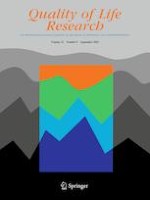17-06-2022
Application of validated mapping algorithms between generic PedsQL scores and utility values to individuals with sickle cell disease
Gepubliceerd in: Quality of Life Research | Uitgave 9/2022
Log in om toegang te krijgenAbstract
Purpose
There is a paucity of empirically estimated health state utility (HSU) values to estimate health-related quality of life among individuals with sickle cell disease (SCD). This study aims to map the Pediatric Quality of Life Inventory generic core scales (PedsQL GCS) to HSUs for children and adolescents with SCD in the United States, using published algorithms, and to assess the construct validity of these HSUs against SCD-specific PedsQL scores.
Methods
We used the published mapping algorithms identified in four published articles, in which the PedsQL GCS was mapped to either the EuroQol-5 Dimension 3-Level, Youth Version or the Child Health Utility 9-Dimension to obtain HSUs. We employed the algorithms to calculate HSUs for a sample of children and adolescents from the Sickle Cell Clinical Research and Intervention Program. To assess the construct validity of the mapped HSUs in SCD patients, we computed Spearman’s correlation coefficient comparing the HSUs with the PedsQL SCD total score and separately with each PedsQL SCD dimension-specific score.
Results
The mean mapped HSU across published algorithms was 0.792 (95% CI: 0.782–0.801). It was significantly higher among children aged 5–12 years than children aged 13–17 years. The Spearman’s correlation coefficient for HSUs versus PedsQL SCD total scores was 0.64 (95% CI: 0.57–0.71). Correlations ranged from 0.40 (95% CI: 0.32–0.48) to 0.60 (95% CI: 0.54–0.66) for HSUs versus PedsQL SCD dimension-specific scores.
Conclusions
The existing mapping algorithms show acceptable construct validity in children and adolescents with SCD. Additional algorithms are needed for adults and for specific SCD comorbidities.
